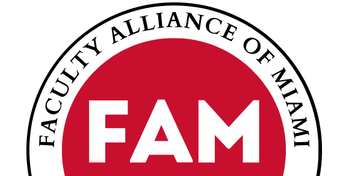
Miami’s new “Boldly Creative Initiatives” plan — funded by $50 million that’s just been swept from department and program budgets—is an effort to respond to a difficult situation for higher ed. Moody’s, the bond rating agency, has just revised the bond outlook for higher ed downward. Higher education’s financial outlook is not good. Publics such as Miami are funded only minimally by the state, and even if Ohio gave publics more leeway on tuition, it would be foolish to raise it much. The public is increasingly distrustful of higher education and its high sticker prices. So what can Miami do? Well, we’re trying a number of things. We’re increasing enrollment. (Hello, contingent faculty to teach all those credit hours. Hello, highly-paid admissions czar.) We’re trying to cut costs. We’re developing revenue-generating programs. And we’re about to create a lot more. That’s what the “Boldly Creative” $50 million is for.
We all want Miami to survive and thrive. But when profit generation becomes the centerpiece of higher ed’s plan to save itself, we may be at risk of transforming the identity and value of the educational enterprise too far. With “Boldly Creative” plans already underway, we must do what we can to mitigate the risk of damage to our core mission, a mission the future depends on: serving the public good by increasing and disseminating knowledge.
The university takes several risks when its plan for supporting its future relies so heavily on for-profit programs. First, when programs are vetted primarily on the basis of their revenue-generating potential, their use to society may be questionable. Second, the potential to reap rewards by partnering with for-profit businesses might encourage us to be less guarded about the influence of private funding on our mission. Third, returns on investment in these programs will be the object of scrutiny, so pressures to keep costs low will be even stronger than they are in other parts of the university. This last point will impact hiring. If you think that “Boldly Creative” programs are going to be, in any significant way, hiring tenure-line faculty, we have a bridge to sell you over Four-Mile-Creek.
When we expand hiring off the tenure track to support increased revenue-building enrollments, we’ll worsen a problem that already plagues Miami: the twin monsters—joined at the hip—of economic precarity and lack of academic freedom. The majority of faculty at Miami face those monsters: they lack basic due-process protections should they be dismissed or not renewed. And most of them work on year-to-year contracts.
In academia, we have a special reason why due-process protections are essential. Universities support the public good by increasing and disseminating knowledge, and we who do that work cannot fulfill that mission if we are at risk of censorship when we seek or share knowledge. Academic freedom is a core value for the university. It rests on economic security and due process, which, in their strongest form, we call tenure. Where tenure is not available, due process protections and economic security should still be extended to faculty in order to protect the educational mission. At Miami, a majority of faculty are deprived of academic freedom protections.
It’s curious that just as the “Boldly Creative” initiatives were announced, the administration put forward another proposal: to “go silent” on the current 5-year limit on terms for Visiting Assistant Professors. Why would the administration make such a proposal now? Well, there are good reasons to ditch the five-year limit. We’d all like to retain good faculty, and many VAPs want to stay.
But if no employment protections for our non-tenure-line faculty are instituted when the VAP limit disappears, our Boldly Creative future could be dystopic: large revenue-generating programs, invisible to most tenure-line faculty, that are taught by a permanent precariate. We’re at risk of expanding our current contingent majority into an ever-greater percentage of faculty who can be fired at any time, who do not participate in governance at Miami, and who have little influence on curriculum despite having more contact with the students than many tenure-line faculty do. In addition, contingent faculty’s conversations with both students and program directors are constrained by their precarity. Non-tenure-line faculty must decide what is sayable in the knowledge that they can be let go at any time with no reason given and no opportunity for appeal.
It’s important to note that Miami’s dependence on precarious faculty is out of step with its own stated policy. MUPIM, our policy manual, contains a robust statement on the value of academic freedom, explicitly noting that academic freedom depends on economic security. The Board of Trustees, to its great credit, adopted the policy back in 1950, in a time when McCarthyism was leading some institutions to require loyalty pledges from faculty. The 1950 Board of Trustees could have had no inkling that in less than seventy years, the policy would have become a hollow statement of values underpinned by protections for only a minority of faculty. At mid-century, a strong majority of faculty were tenured or on the tenure-track. As late as 2001 (the first year for which we could locate federal figures), 79% of faculty at Miami were tenured or on the tenure track. But the situation has changed. As of 2016, 51% of faculty at Miami did not have explicit due process rights stated in MUPIM, and the future looks worse: the same year, 78% of full-time faculty hired were contingent faculty.
What can we do? University Senate, which votes on MUPIM changes, has the power to update Miami policy (if the Board of Trustees accepts the revisions). Senate must act soon to strengthen MUPIM on academic freedom and economic security for non-tenure-line faculty before a “Boldly Creative” revenue-focused tide swamps Miami’s educational mission.

Leave a Reply